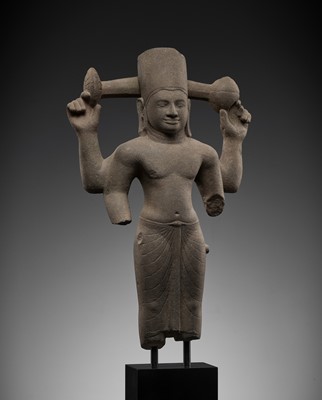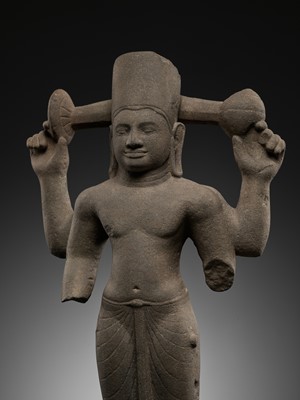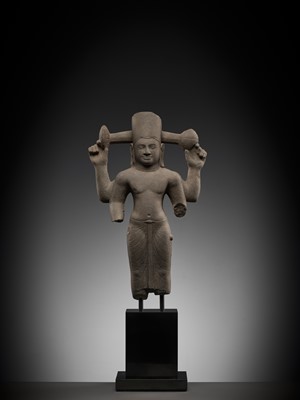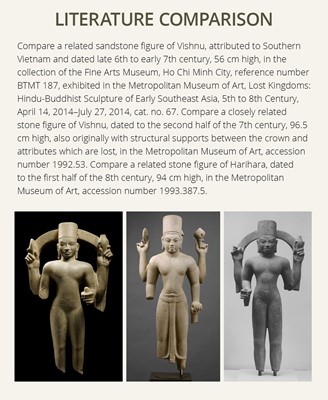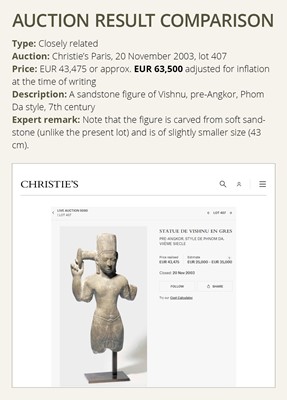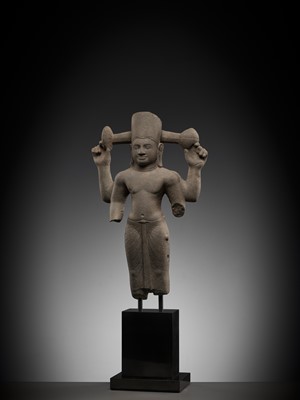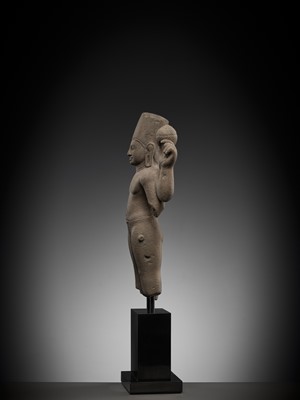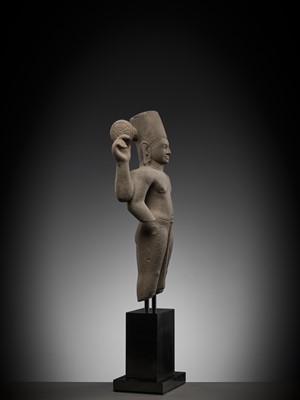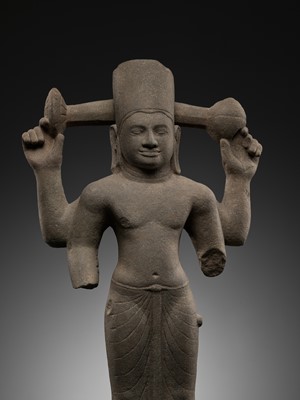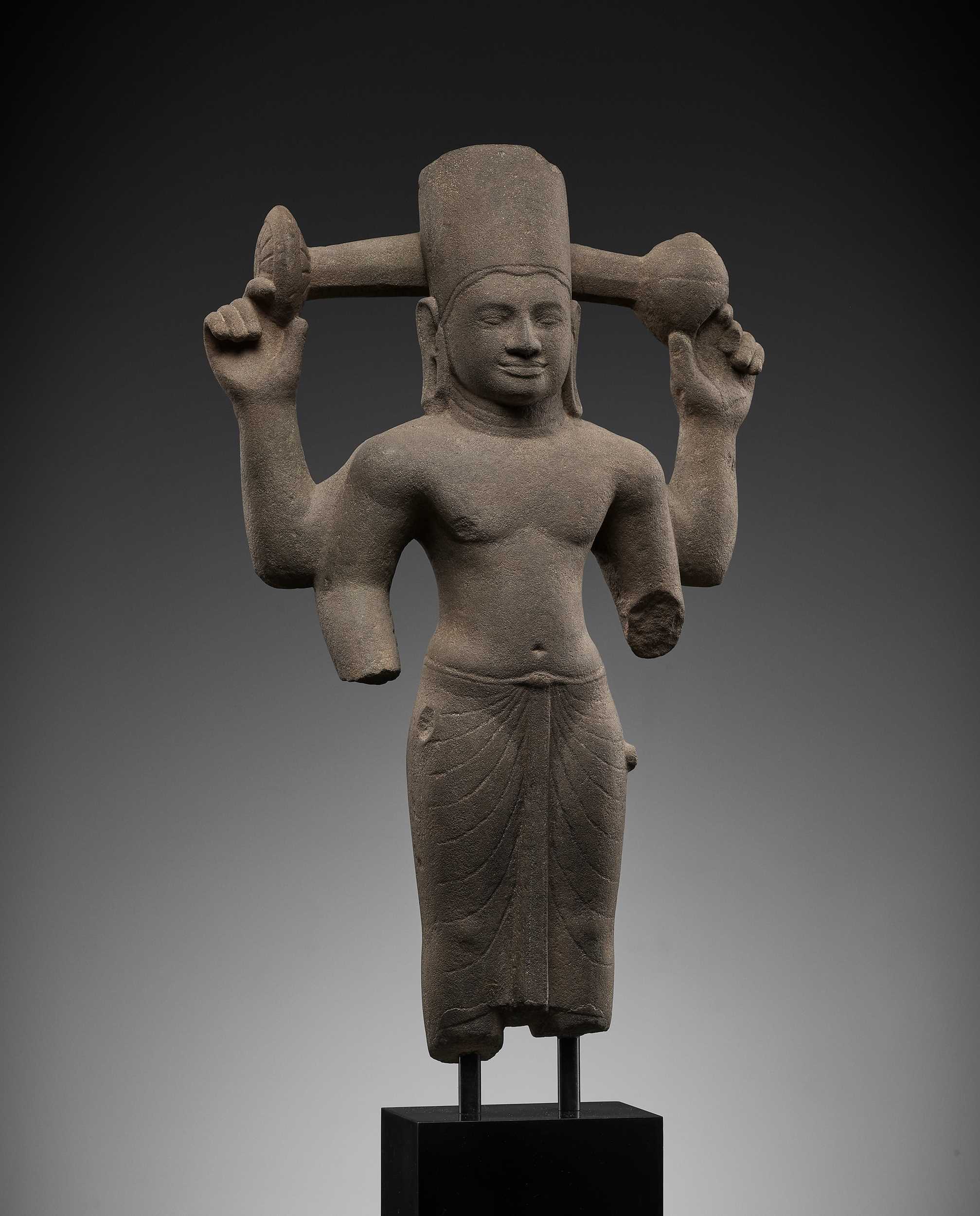2nd Jun, 2023 11:00
Fine Chinese Art / 中國藝術集珍 / Buddhism & Hinduism
182
† A STONE FIGURE OF VISHNU, PRE-ANGKOR PERIOD, PHNOM DA STYLE
Sold for €13,100
including Buyer's Premium
Ancient region of Funan, Mekong Delta, 7th century. Well carved standing, holding a conch and disk in his uppermost hands, each connected by carved brackets to the cylindrical headdress, wearing a pleated sampot, the serene face with almond-shaped eyes and full lips forming a calm smile, flanked by long pierced pendulous earlobes.
Provenance: From a notable collector in London, United Kingdom.
Condition: Excellent condition, commensurate with age. Extensive wear, encrustations, losses, signs of weathering and erosion, minor nicks, cracks and scratches.
Dimensions: Height 50 cm (excl. base) and 75 cm (incl. base)
Mounted on an associated base. (2)
The present figure encapsulates the subtle elegance of the late Funan style; the confident, noble presentation represents an established local aesthetic, although some aspects of its appearance recall the Indian Gupta tradition. Nevertheless, the embellishment one would find in north Indian sculpture of the period is absent, enhancing the svelte physique and cerebral strength, without reducing the sense of majesty. The slender body form replicates the ethnic Southeast Asian appearance, being both fine boned but physically powerful. Vishnu stands in a slightly relaxed pose, with his right knee bent; his chest and shoulder muscles are enlarged to accommodate the four arms and the effect is elegant both at the front and the back, illustrating an understanding of human anatomy, which is not always evident in sculptures of the period. The short, thick neck is widened further by the long ears and strengthens the otherwise vulnerable area around the head. The face has strong features, arched eyebrows and a generous, sensitive mouth encapsulating the beauty of the finest Funan images.
Vishnu wears a knee-length garment, a practical local fashion, unlike the long robes of earlier sculptures that maintain the Gupta, Indian tradition. This garment, the sampot can kpin, is created from a long length of cloth wound once around the body and then pleated to form a scarf that passes between the legs from back to front, fastening at the waist. The central pleat provides additional reinforcement to the sculpture.
Stone images from the late Funan period reflect an extraordinary degree of confidence and technical expertise; this suggests that sculptors followed prototypes evolved during earlier centuries that have not survived. Unlike their Indian contemporaries, who preferred to work in the relatively easily carved sandstones, Funan’s sculptors seem to have deliberately chosen hard, difficult-to-work stones. There was a shortage of workable stone in the region; the earliest stone sculptures were possibly fashioned from boulders retrieved from the River Mekong and carried downstream during the annual floods. Later on, stone was carefully sourced and brought to the delta region.
Almost all found stone sculptures in the Phnom Da style seem to belong to the realm of Vishnu and his incarnations, like this example. The Phnom Da style also seems rather homogenous compared to other stylistic phases.
Expert’s note: A detailed academic commentary on the present lot, elaborating on the history and art of Funan as well as the evolution of Vishnu images in the Mekong Delta, and showing many further comparisons to examples in both public and private collections, is available upon request. To receive a PDF copy of this academic dossier, please refer to the department.
Literature comparison:
Compare a related sandstone figure of Vishnu, attributed to Southern Vietnam and dated late 6th to early 7th century, 56 cm high, in the collection of the Fine Arts Museum, Ho Chi Minh City, reference number BTMT 187, exhibited in the Metropolitan Museum of Art, Lost Kingdoms: Hindu-Buddhist Sculpture of Early Southeast Asia, 5th to 8th Century, April 14, 2014–July 27, 2014, cat. no. 67. Compare a closely related stone figure of Vishnu, dated to the second half of the 7th century, 96.5 cm high, also originally with structural supports between the crown and attributes which are lost, in the Metropolitan Museum of Art, accession number 1992.53. Compare a related stone figure of Harihara, dated to the first half of the 8th century, 94 cm high, in the Metropolitan Museum of Art, accession number 1993.387.5.
Auction result comparison:
Type: Closely related
Auction: Christie’s Paris, 20 November 2003, lot 407
Price: EUR 43,475 or approx. EUR 63,500 adjusted for inflation at the time of writing
Description: A sandstone figure of Vishnu, pre-Angkor, Phom Da style, 7th century
Expert remark: Note that the figure is carved from soft sandstone (unlike the present lot) and is of slightly smaller size (43 cm).
Ancient region of Funan, Mekong Delta, 7th century. Well carved standing, holding a conch and disk in his uppermost hands, each connected by carved brackets to the cylindrical headdress, wearing a pleated sampot, the serene face with almond-shaped eyes and full lips forming a calm smile, flanked by long pierced pendulous earlobes.
Provenance: From a notable collector in London, United Kingdom.
Condition: Excellent condition, commensurate with age. Extensive wear, encrustations, losses, signs of weathering and erosion, minor nicks, cracks and scratches.
Dimensions: Height 50 cm (excl. base) and 75 cm (incl. base)
Mounted on an associated base. (2)
The present figure encapsulates the subtle elegance of the late Funan style; the confident, noble presentation represents an established local aesthetic, although some aspects of its appearance recall the Indian Gupta tradition. Nevertheless, the embellishment one would find in north Indian sculpture of the period is absent, enhancing the svelte physique and cerebral strength, without reducing the sense of majesty. The slender body form replicates the ethnic Southeast Asian appearance, being both fine boned but physically powerful. Vishnu stands in a slightly relaxed pose, with his right knee bent; his chest and shoulder muscles are enlarged to accommodate the four arms and the effect is elegant both at the front and the back, illustrating an understanding of human anatomy, which is not always evident in sculptures of the period. The short, thick neck is widened further by the long ears and strengthens the otherwise vulnerable area around the head. The face has strong features, arched eyebrows and a generous, sensitive mouth encapsulating the beauty of the finest Funan images.
Vishnu wears a knee-length garment, a practical local fashion, unlike the long robes of earlier sculptures that maintain the Gupta, Indian tradition. This garment, the sampot can kpin, is created from a long length of cloth wound once around the body and then pleated to form a scarf that passes between the legs from back to front, fastening at the waist. The central pleat provides additional reinforcement to the sculpture.
Stone images from the late Funan period reflect an extraordinary degree of confidence and technical expertise; this suggests that sculptors followed prototypes evolved during earlier centuries that have not survived. Unlike their Indian contemporaries, who preferred to work in the relatively easily carved sandstones, Funan’s sculptors seem to have deliberately chosen hard, difficult-to-work stones. There was a shortage of workable stone in the region; the earliest stone sculptures were possibly fashioned from boulders retrieved from the River Mekong and carried downstream during the annual floods. Later on, stone was carefully sourced and brought to the delta region.
Almost all found stone sculptures in the Phnom Da style seem to belong to the realm of Vishnu and his incarnations, like this example. The Phnom Da style also seems rather homogenous compared to other stylistic phases.
Expert’s note: A detailed academic commentary on the present lot, elaborating on the history and art of Funan as well as the evolution of Vishnu images in the Mekong Delta, and showing many further comparisons to examples in both public and private collections, is available upon request. To receive a PDF copy of this academic dossier, please refer to the department.
Literature comparison:
Compare a related sandstone figure of Vishnu, attributed to Southern Vietnam and dated late 6th to early 7th century, 56 cm high, in the collection of the Fine Arts Museum, Ho Chi Minh City, reference number BTMT 187, exhibited in the Metropolitan Museum of Art, Lost Kingdoms: Hindu-Buddhist Sculpture of Early Southeast Asia, 5th to 8th Century, April 14, 2014–July 27, 2014, cat. no. 67. Compare a closely related stone figure of Vishnu, dated to the second half of the 7th century, 96.5 cm high, also originally with structural supports between the crown and attributes which are lost, in the Metropolitan Museum of Art, accession number 1992.53. Compare a related stone figure of Harihara, dated to the first half of the 8th century, 94 cm high, in the Metropolitan Museum of Art, accession number 1993.387.5.
Auction result comparison:
Type: Closely related
Auction: Christie’s Paris, 20 November 2003, lot 407
Price: EUR 43,475 or approx. EUR 63,500 adjusted for inflation at the time of writing
Description: A sandstone figure of Vishnu, pre-Angkor, Phom Da style, 7th century
Expert remark: Note that the figure is carved from soft sandstone (unlike the present lot) and is of slightly smaller size (43 cm).
Zacke Live Online Bidding
Our online bidding platform makes it easier than ever to bid in our auctions! When you bid through our website, you can take advantage of our premium buyer's terms without incurring any additional online bidding surcharges.
To bid live online, you'll need to create an online account. Once your account is created and your identity is verified, you can register to bid in an auction up to 12 hours before the auction begins.
Intended Spend and Bid Limits
When you register to bid in an online auction, you will need to share your intended maximum spending budget for the auction. We will then review your intended spend and set a bid limit for you. Once you have pre-registered for a live online auction, you can see your intended spend and bid limit by going to 'Account Settings' and clicking on 'Live Bidding Registrations'.
Your bid limit will be the maximum amount you can bid during the auction. Your bid limit is for the hammer price and is not affected by the buyer’s premium and VAT. For example, if you have a bid limit of €1,000 and place two winning bids for €300 and €200, then you will only be able to bid €500 for the rest of the auction. If you try to place a bid that is higher than €500, you will not be able to do so.
Online Absentee and Telephone Bids
You can now leave absentee and telephone bids on our website!
Absentee Bidding
Once you've created an account and your identity is verified, you can leave your absentee bid directly on the lot page. We will contact you when your bids have been confirmed.
Telephone Bidding
Once you've created an account and your identity is verified, you can leave telephone bids online. We will contact you when your bids have been confirmed.
Classic Absentee and Telephone Bidding Form
You can still submit absentee and telephone bids by email or fax if you prefer. Simply fill out the Absentee Bidding/Telephone bidding form and return it to us by email at office@zacke.at or by fax at +43 (1) 532 04 52 20. You can download the PDF from our Upcoming Auctions page.
How-To Guides
How to Create Your Personal Zacke Account
How to Register to Bid on Zacke Live
How to Leave Absentee Bids Online
How to Leave Telephone Bids Online
中文版本的操作指南
创建新账号
注册Zacke Live在线直播竞拍(免平台费)
缺席投标和电话投标
Third-Party Bidding
We partner with best-in-class third-party partners to make it easy for you to bid online in the channel of your choice. Please note that if you bid with one of our third-party online partners, then there will be a live bidding surcharge on top of your final purchase price. You can find all of our fees here. Here's a full list of our third-party partners:
- 51 Bid Live
- EpaiLive
- ArtFoxLive
- Invaluable
- LiveAuctioneers
- the-saleroom
- lot-tissimo
- Drouot
Please note that we place different auctions on different platforms. For example, in general, we only place Chinese art auctions on 51 Bid Live.
Bidding in Person
You must register to bid in person and will be assigned a paddle at the auction. Please contact us at office@zacke.at or +43 (1) 532 04 52 for the latest local health and safety guidelines.
